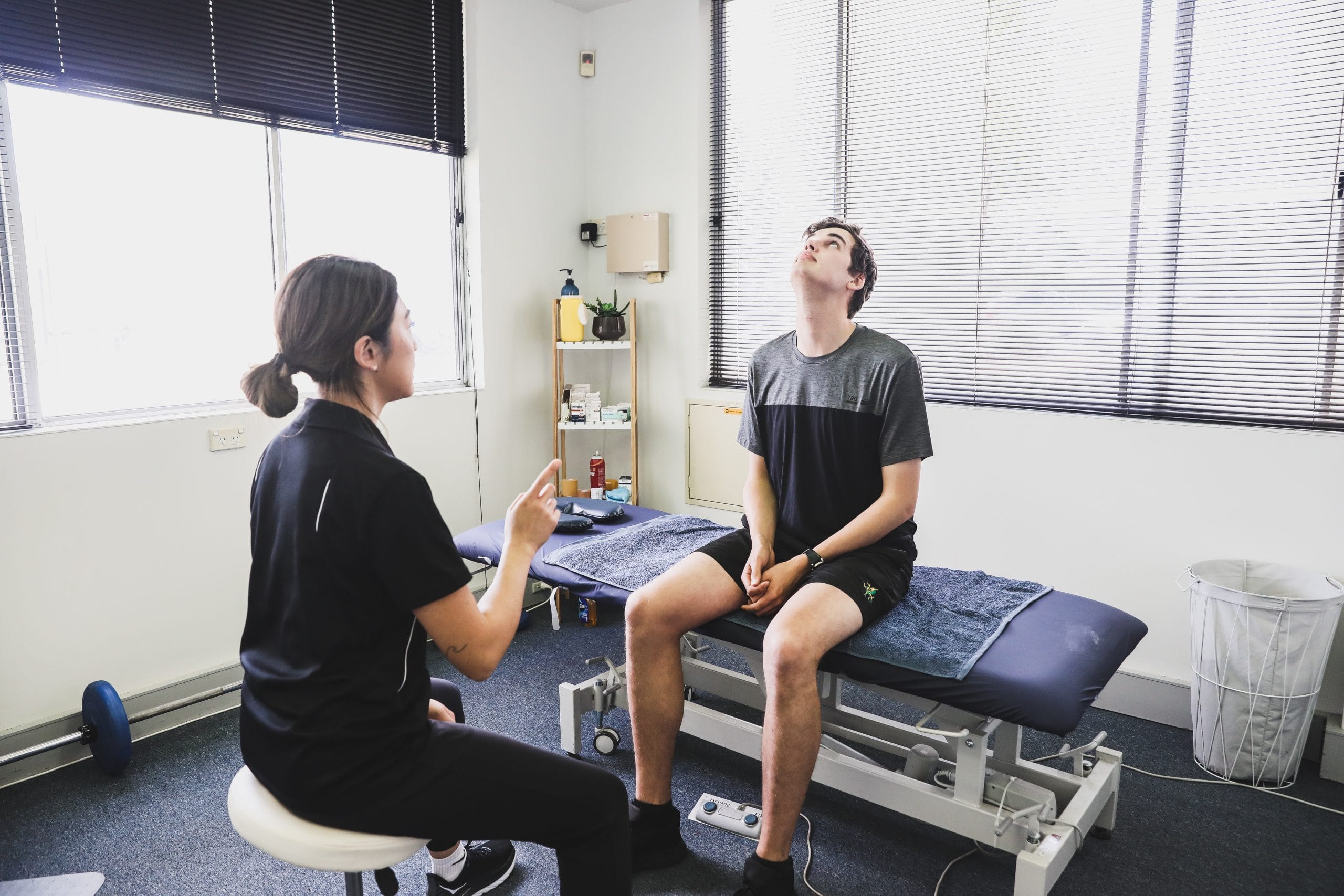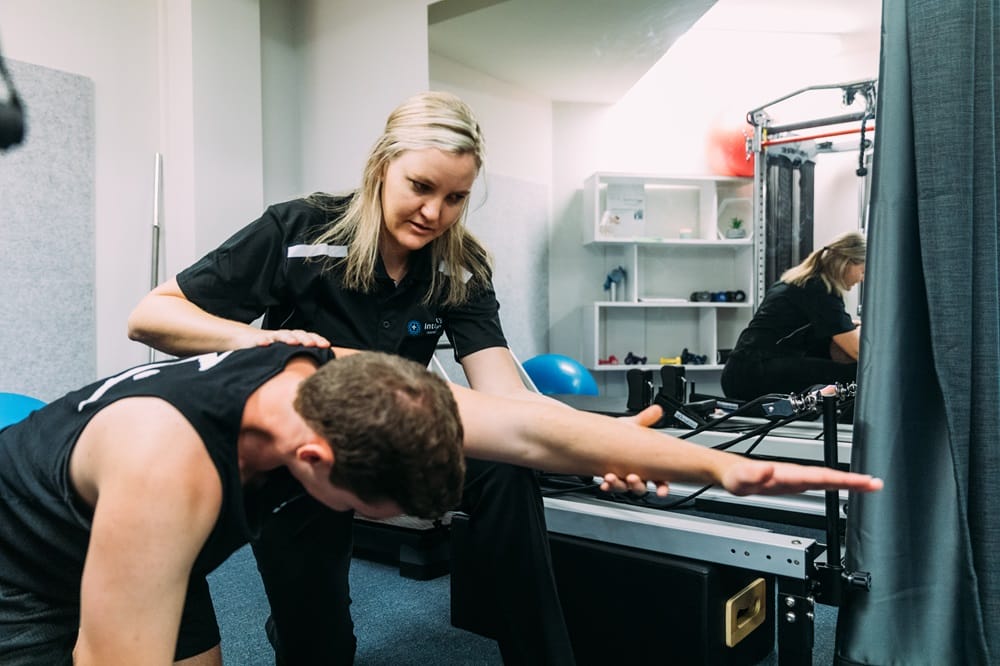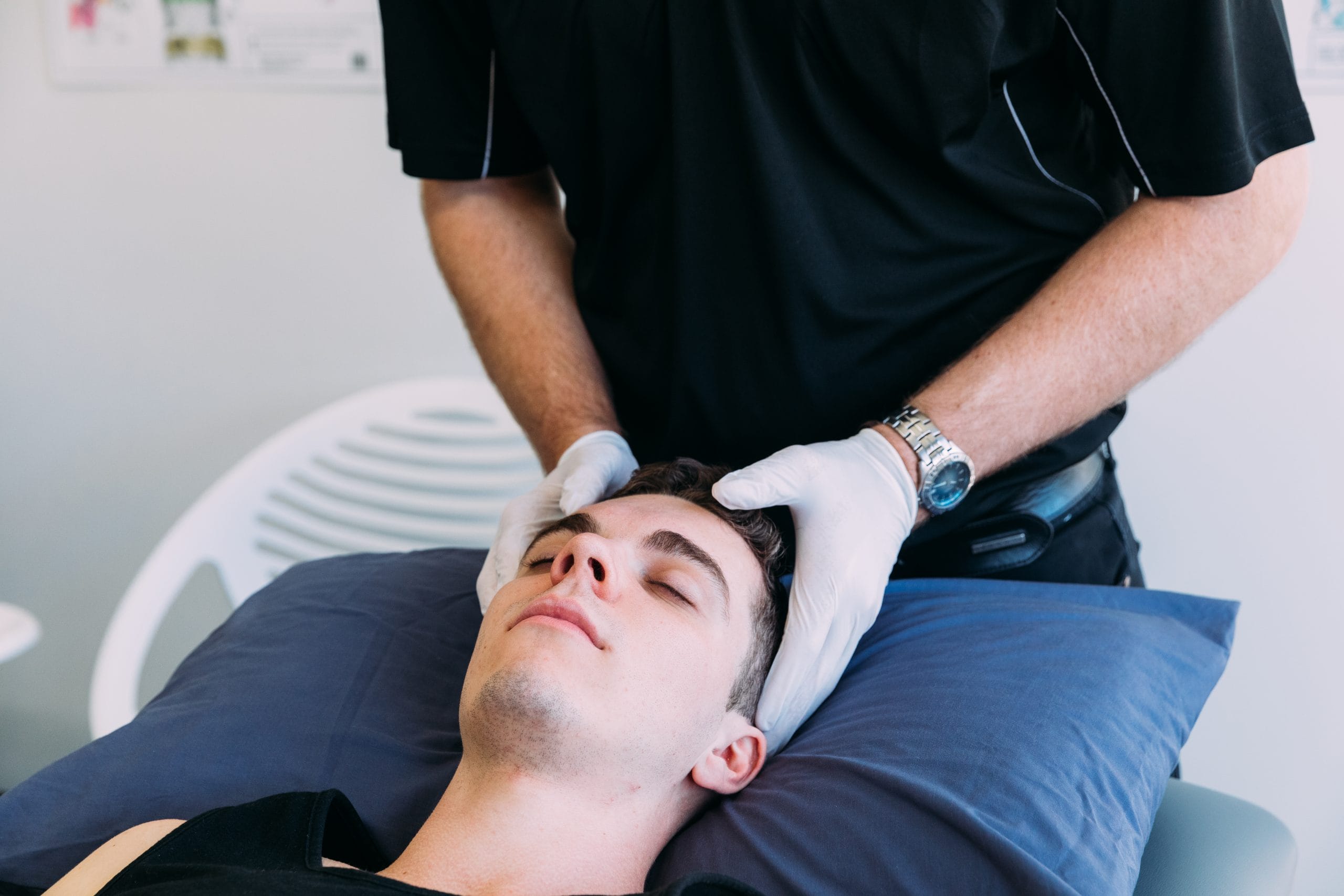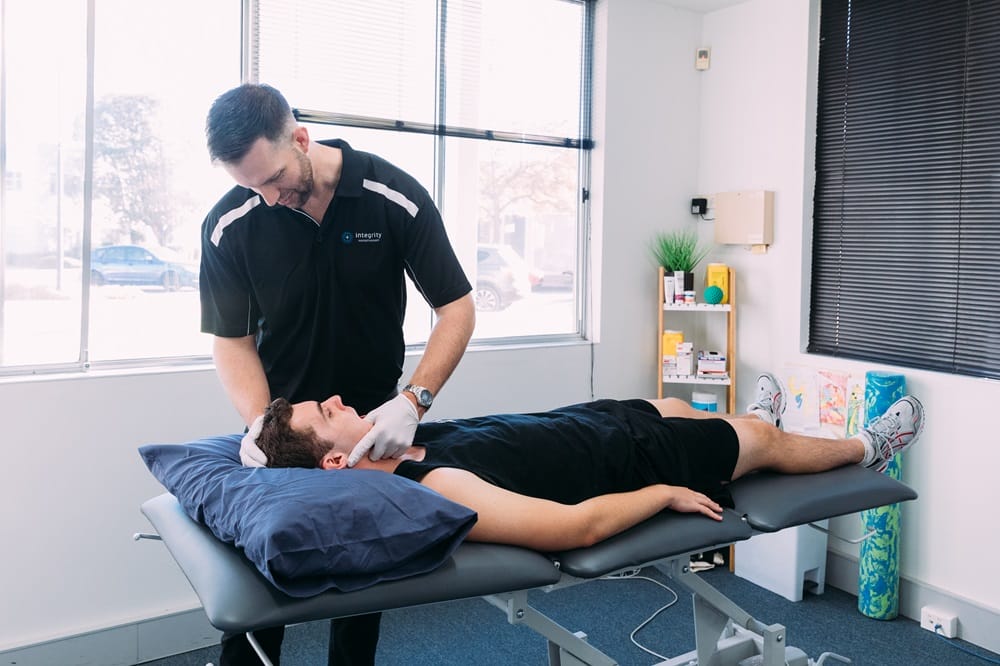
TMJ dysfunction affects millions worldwide, a silent perpetrator of pain and discomfort, impacting the quality of life and overall well-being. Recognising its significance is the first step to finding relief and regaining the joy of a pain-free life.
What is the temporomandibular joint?
Our temporomandibular joint (TMJ) is located at the juncture where the jawbone meets the skull at front of each ear. An intricate joint, our TMJ enables a large degree of movement that grants us the power of speech, expression, and sustenance.
This joint allows us to chew, talk, yawn and a myriad of other things essential to daily life. The TMJ coordinates the muscles, ligaments, and bones.
What is TMJ dysfunction?
Temporomandibular Joint Dysfunction, also known as TMJ dysfunction or TMD, is a condition characterised by pain and limited movement in the jaw and surrounding muscles. The temporomandibular joint connects your jawbone to your skull, acting like a sliding hinge – but when it’s not functioning correctly, it can create issues with your chewing and mouth opening as well as jaw locking, and even changes in the alignment of your teeth.
And, the thing is, it doesn’t just stop with the physical impact – it can also cause a lot of stress, frustration, and can really impact your quality of life.
When it comes to TMJ dysfunction, knowledge and timely intervention is important in finding treatment, relief, and restoration of a harmonious daily life.
Causes of TMJ dysfunction
Jaw injury
A blow or impact to the jaw can cause sensitisation, inflammation or damage to the Temporomandibular Joint, leading to TMJ Dysfunction. This injury can result from accidents, falls, or sports-related impacts that cause dislocation or bruising to the jaw area.
Arthritis
Forms of arthritis, such as osteoarthritis and rheumatoid arthritis, can impact your TMJ. This can lead to inflammation, deterioration, and eventual damage to the joint, manifesting as TMJ Dysfunction.
Jaw misalignment
When the jaw is not properly aligned, it can put stress on your TMJ. This misalignment can be congenital or develop over time, causing an imbalance in jaw function, and leading to TMJ Dysfunction.
Teeth grinding
Chronic teeth grinding, or bruxism, puts excessive pressure on the TMJ. Over time, this relentless force can wear down the joint and create muscle imbalances leading to pain and limited jaw mobility.
Stress-induced jaw muscle tightness
Constant stress can lead to involuntary jaw clenching and cause muscle tightness and strain on the TMJ. Over time, this consistent tension can develop into TMJ Dysfunction.
Common symptoms of TMJ dysfunction
Understanding the symptoms of TMJ dysfunction is the first step in resolving it. Look out for the below symptoms if you suspect jaw joint issues.
- Jaw Pain or Tenderness: Sporadic or consistent, often worsened by jaw movement.
- Difficulty Chewing: Causes pain, grating sensation, or uncomfortable restriction.
- Aching Facial Pain: Radiates across the face, concentrated in the jaw area, aggravated by jaw use.
- Locked or Limited Jaw Movement: Hinders speaking, eating, and yawning with possible ‘locked’ jaw.
- Earache or Ringing in Ears: Highlights TMJ dysfunction’s impact beyond the jaw, may include tinnitus.
- Popping or Clicking: Indicative of issues in the TMJ region when mouth opens.
- Headaches: Pain from the jaw radiating upwards causing headaches.
- Facial swelling: Inflammation can result in the sides of your face looking swollen.
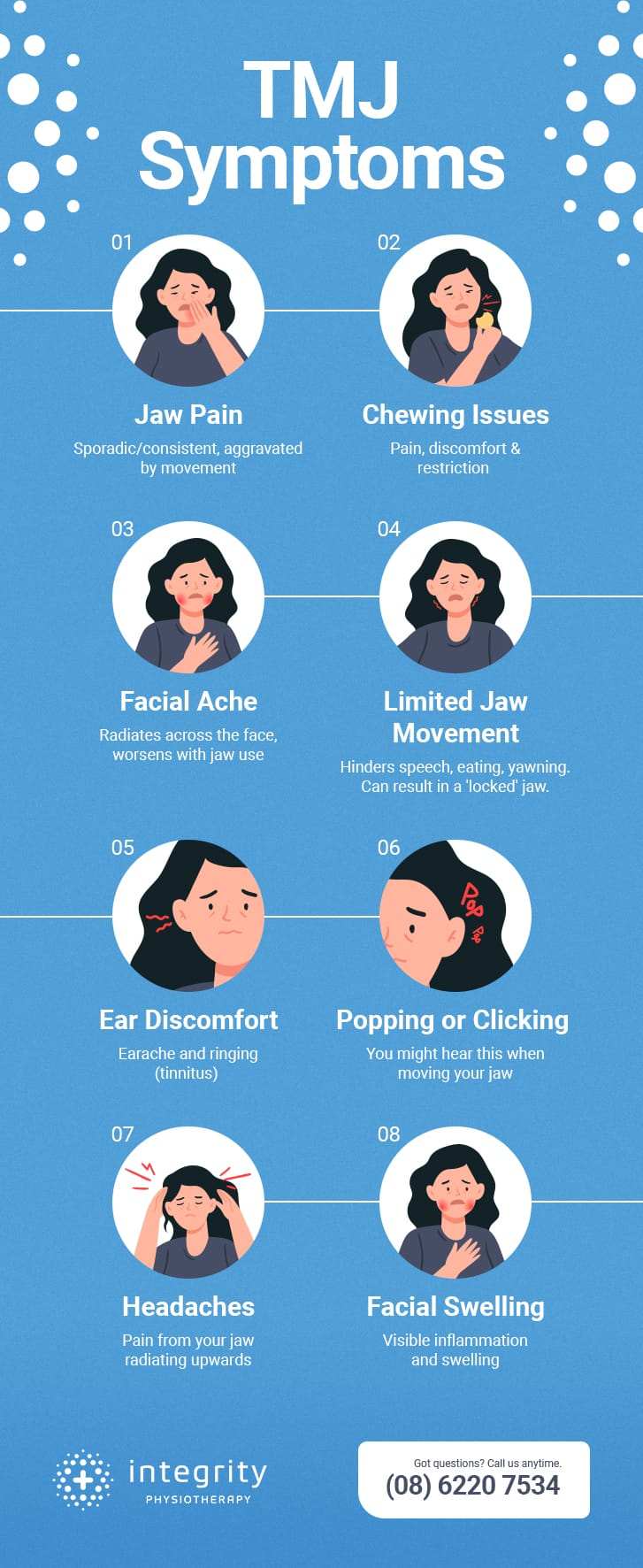
The role of physiotherapy treatment for TMJ
TMJ physiotherapy can be effective in reducing pain and improving the function of your jaw joint and muscles. Here’s how.
Pain relief through targeted exercises
One of the key benefits of physiotherapy in alleviating TMJ dysfunction is pain relief. Physiotherapists design targeted exercises that help loosen or strengthen the jaw muscles and improve their flexibility. These exercises, tailored to each individual’s condition and capacity, work towards gradually reducing pain, restoring function, and improving the overall health of the jaw muscles and joints.
Improvement in jaw mobility
With physiotherapy intervention targeted at your TMJ dysfunction, you can expect to see improved mobility and flexibility in your jaw, which is vital for daily activities like speaking, eating, and yawning.
Helping you manage and prevent symptoms
Beyond the immediate relief you’ll likely experience with targeted physical therapy, you’ll also be provided with the necessary exercises and strategies to manage your symptoms alongside your physiotherapy. This allows you to be part of the process, taking control of your pain, achieving sustained relief and reducing the risk of recurrence.
Physiotherapy treatment for TMJ
Jaw exercises and stretches
Jaw exercises and stretches are an essential part of TMJ dysfunction physiotherapy treatment. These activities, as part of your TMJ physiotherapy, focus on gently working the jaw muscles, enhancing their strength and flexibility. The goal is to fortify the jaw against future issues and alleviate current symptoms, laying the foundation for a stronger, more resilient jaw structure.
Jaw movements often become asymmetrical and poorly controlled. Also,isolated weakness in specific muscle groups can be identified in relation to chronic myofascial/muscular temporomandibular disorders. Correcting muscle imbalances and muscle weakness is a critical part of restoring normal biomechanics and motion of the jaw. Changing the way your muscles are recruited can often give relief of discomfort in days to weeks.
As part of your assessment, you as the patient will be able to see what your physiotherapist is identifying and understand why you are in pain. This makes you part of the process, walking the journey with your physiotherapist. What you understand, you then have the ability to change with a tailored, specific home program.
Dry needling
This involves inserting thin needles into specific trigger points in the jaw and neck areas, often providing immediate relief and muscle relaxation. By reducing muscle tension and enhancing blood flow, dry needling can help with jaw mobility and pain.
READ MORE: Dry needling for jaw clenching – does it work?
Massage and myofascial release techniques
Massage and myofascial release techniques hold a special place in TMJ dysfunction treatment. They focus on releasing muscle tightness and improving blood flow to the affected area. These techniques not only offer immediate relief but also contribute to the long-term health and functionality of the jaw.
Joint mobilisation
Joint mobilisation is a hands-on therapy technique. This method is used to gently move the joint in specific directions to relieve pain and improve mobility. It is a critical aspect of physiotherapy treatment for some types of TMJ dysfunction, working towards restoring the natural movement of the jaw and relieving the discomfort associated with the condition.
Home remedies for TMJ dysfunction
Pain relief and management
Cold and heat therapy
Both cold and heat therapy can play a role in easing pain from temporomandibular disorders. Cold packs can be applied to the jaw area to reduce inflammation and numb the nerves, giving you some immediate relief from pain.
Heat packs can enhance blood circulation, relax your jaw muscles, and alleviate discomfort.
Over-the-counter pain relief
There are a number of over-the-counter pain relievers, like ibuprofen, that can help manage pain and inflammation. You may also be recommended or prescribed muscle relaxants or medications that calm your nervous system especially if your TMJ dysfunction is causing muscle spasms.
Jaw support
You can support your jaw and prevent further pain by avoiding excessive movement and providing gentle support, especially during yawns or extensive talking.
Exercises and stretches
Jaw exercises
Jaw exercises aim to strengthen the jaw muscles, enhance flexibility, and improve the range of motion, ensuring the restoration of normal jaw function and the alleviation of discomfort.
- Relaxed jaw exercise: this can help relax your jaw and alleviate tension and tightness. To do it, sit or stand comfortably and place your tongue behind your upper front teeth. Allow your teeth to part and relax your jaw muscles.
- Chin tucks: this can strengthen your neck muscles, improve your posture, and provide relief from jaw and neck tension. Start by sitting or standing straight. Gently tuck your chin to your chest and hold it for five seconds while looking down. Return to the start position and repeat.
- Resisted opening and closing: this enhances jaw muscle strength and resilience. Place your thumb or two fingers under your chin and open your mouth slowly, while applying gentle resistance with your fingers. For closing, place your thumb and finger on the your chin and apply gentle resistance when closing your mouth.
- Gentle jaw stretch: this increases jaw flexibility and range of motion. To do this, open your mouth as wide as comfortably possible. Hold for 5-10 seconds, then gently close it.
Neck and shoulder stretches
Neck and shoulder exercises are a great way to release accumulated tension and improve your posture, which has a flow on effect to your jaw function and overall health. Look at using a few of the below in your everyday routine.
- Neck tilts: this releases neck tension, improves flexibility, and enhances blood circulation to the neck and jaw region. To do it, sit or stand comfortably. Gently tilt your head to one side, bringing your ear towards your shoulder, until a stretch is felt on the opposite side. Hold for 15-20 seconds, then switch sides.
- Shoulder rolls: this relieves shoulder and upper back tension and promotes improved posture and reduced strain on the jaw. In a seated or standing position, roll your shoulders up, back, down, and forward in a circular motion. Repeat in the opposite direction.
- Neck rotations: this helps with neck flexibility and alleviates stiffness, supporting optimal jaw function. Gently rotate your head to one side, aligning your chin with the shoulder, and hold the position for about 20 seconds. Repeat on the other side.
Stress management
Mindfulness and meditation
It’s surprising how much stress can impact our muscles! If you’re dealing with a lot of stress, sometimes not obvious to you, and your jaw muscles become tense, this can contribute to your TMJ pain. Practicing mindfulness and meditation or yoga to reduce stress is a great way to prevent involuntary jaw clenching and teeth grinding.
Breathing exercises
Similarly, using breathing exercises daily can help relax your mind and body, and release muscle tension in the jaw area.
Lifestyle adjustments
Sleep in a good position
A supportive sleep position can be a real game changer when it comes to jaw pain. Avoid sleeping on your stomach, and make sure you’re using a firm pillow for adequate neck and jaw support.
Eat a balanced diet
It may seem like an odd one to include, but a lot of foods have anti-inflammatory properties that can contribute to your overall muscle and joint health.
READ MORE: How the mediterranean diet can help with inflammation
Avoid chewy foods
This one is a given, but avoid chewy, hard, or crunchy foods to reduce stress on your jaw joints and muscles – at least until the pain has reduced and you’re feeling a bit better. Stick to the soft foods for a bit!
Preventative measures
Optimal posture for you
The shoulders, neck, and jaw are all closely connected, so maintaining a comfortably upright posture can help reduce tension and subsequent jaw pain. This is especially the case when it comes to using your phone and other electronic devices. Posture is not as simple as you think and we can’t see ourselves. Some people can’t find the right posture for them and this can take some good advice from an experienced physiotherapist.
READ MORE: The rise of ‘tech neck’ and its impact
Regular breaks
This one may seem obvious, but we’re all often really busy, and proper breaks can be few and far between. Remember to take regular breaks during work or other activities that require a lot of talking, singing, or chewing to give your jaw ample time to rest.
Dental check ups
Regular dental check ups are essential for a number of reasons, but making sure your teeth are aligned and your oral health is in optimal condition is important in preventing undue stress on the jaw. If you’re a jaw clencher or teeth grinder when you sleep, you may be able to get a splint to help.
Book your TMJ physio appointment today
TMJ dysfunction doesn’t need to be a lifelong sentence of pain and limitation. Understanding your condition, recognising the symptoms, and seeking timely professional physiotherapy intervention can pave the path to recovery and relief.
If you’re dealing with TMJ pain, reach out to our friendly team for an appointment, and take the first step in regaining a pain-free life.

